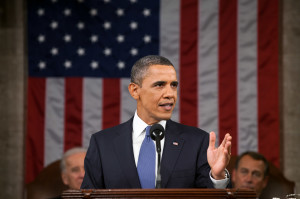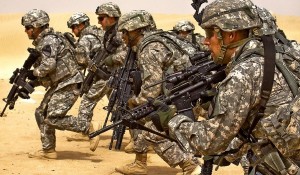During the past few years, we have all heard much about the potential threat posed by Iran’s nuclear program, as well as the negotiations held between Iran and the United States and five other world powers (the so-called P5+1) to end the impasse over Iran’s nuclear program. Representatives from these countries have convened in Europe about once a month over the past two years to negotiate behind closed doors, emerging only to pose for photo opportunities and offer ambiguous messages of hope to schedule even more negotiating sessions in the future. Notwithstanding rumors of gradual progress that have usually been spread after these negotiating sessions, the negotiations as a whole have been largely stalemated. This has increased the likelihood of Congress passing legislation to restrict diplomacy or impose new sanctions on Iran, actions that would almost certainly eliminate the possibility of reaching any nuclear deal with Iran.
In his annual State of the Union address earlier this week (Washington Post), President Barack Obama defended the Iran nuclear negotiations, warned the Republican-controlled Congress against passing legislation to impose new sanctions on Iran, and threatened to veto any new sanctions because “it doesn’t make sense.” The President’s diplomacy toward Iran has been a target of severe criticism by many Republicans from the very beginning. This is not surprising since imposing sanctions on Iran has been popular with most constituents and has involved no political cost. In an interview earlier this month (Newsmax), Lindsay Graham, a prominent Republican Senator, gave a scathing assessment of President Obama’s Iran policy by stating that Obama “approached Iran with an open hand, not a clenched fist, but I think that his leading from behind model has not served our national security interests well.” The South Carolina Republican also stated that in his view “The Iranian nuclear ambitions are the biggest threat to the world in general.” With the new Republican majority in Congress, such anti-diplomacy rhetoric in connection with the Iran nuclear issue is likely to get worse in the near future. As such, it is worth examining some of the facts and basic issues related to the nuclear diplomacy with Iran here.
Although the elimination of nuclear weapons would solve many global disputes, it is almost impossible to convince everyone to agree to this idea because of the multiple factors that cause each individual country to want nuclear weapons. By 1967, five countries possessed nuclear weapons; the United States, the Soviet Union, China, France, and Great Britain. To prevent the spread of nuclear weapons to other countries, the Nuclear Non-Proliferation Treaty (NPT) was established in 1970 (Bunn). It prohibits the five countries that had nuclear weapons in 1967 from giving such weapons to other countries, and it also prohibits all other countries that join the NPT from acquiring nuclear weapons. All countries with significant nuclear activities have joined the NPT, except for India, Pakistan, Israel, and North Korea. India, Pakistan, and Israel built weapons outside the treaty and rejected its constraints, while North Korea, which had been a member of the NPT, pulled out in 2003 (Bunn).
Iran and North Korea, as well as several other countries, have bent or broken their anti-nuclear rules. The fear is that if other countries follow these patterns of behavior, there will be mass chaos. As more governments look to nuclear power as an energy source, potentially hazardous nuclear substances will spread more widely. Without stricter controls over the technologies for enriching uranium, primary usage as a source of energy could eventually be abused for weapons-making. There are also fears that terrorists will find easier access to bombs or other dangerous materials as more lines are crossed in the bomb-making business.
What has made Iran’s nuclear program a major focus of global politics today is the suspicion that this program would ultimately be used for nuclear weapons development. The official position of the Iranian government has been that its nuclear activities are entirely for peaceful purposes, and that it has no intentions of proliferation. However, the Bush administration aimed to place Iran at the forefront of the world’s nuclear agenda. President Bush tried to make the international community unite around the idea that Iran was a nuclear threat. Many members of the international community, especially the United States, placed a great deal of pressure on Iran to increase transparency of their suspected nuclear activities. As a result of persistently increasing anti-Iranian rhetoric from the west, Iran allowed the International Atomic Energy Agency (IAEA) greater access to their hubs of nuclear activity. The IAEA temporarily diffused international pressure to increase transparency. However, no definitive answer to the nuclear question has been found.
America and Israel often give reference to military action to stop Iran’s suspected nuclear-weapons program. Although Israel claims that diplomacy is preferable to war, it worries that with passing time, Iran’s knowledge of using the enriched uranium to create a powerful weapon advances. While the location of Iran and its nuclear facilities, as well as the threats posed by them, make it questionable whether there will really be an attack upon Iran, it could get more serious due to Iran’s expanding uranium-enrichment program, faltering diplomatic efforts to halt it, and a nervous Israel.
Heating up the controversy are several recent media reports (Albright, Shire; Shanker), as well as government officials, who have interpreted a recent IAEA report (IAEA) on Iran’s nuclear program to suggest that Iran has enough enriched uranium to make a nuclear weapon. For example, in a March 1, 2009 interview, CNN’s John King asked Admiral Mike Mullen (Chairman of the Joint Chiefs of Staff): “Does Iran have enough fissile material to make a bomb?” Admiral Mullen responded, “We think they do.” Admiral Mullen’s spokesperson later clarified that he was referring only to the IAEA’s February 2009 findings (IAEA) that Iran has 1,010 kg of low-enriched uranium. The recent media reports suggesting that Iran has enough highly enriched uranium to make a nuclear weapon are misleading with respect to Iran’s existing capabilities, and greatly overestimate the amount of weapon-grade uranium that could be produced from Iran’s low-enriched uranium stock.
(to be continued)
Washington Post, “Obama’s State of the Union dress 2015”, The Washington Post, 20 Jan 2015. Web. 21 Jan 2015. http://www.washingtonpost.com/politics/transcript-state-of-the-union-address-2015-remarks-as-prepared-for-delivery/2015/01/20/fd803c4c-a0ef-11e4-b146-577832eafcb4_story.html
Newsmax, “Lindsay Graham: Iran Nuclear Push is Biggest Threat to World”, Newsmax, 2 Jan 2015. Web. 21 Jan 2015. http://www.newsmax.com/Newsfront/Lindsey-Graham-nuclear-program/2015/01/02/id/616094/
Bunn, George, “Non-Proliferation of Nuclear Weapons, Treaty on the,” The Oxford Companion to American Military History (2000) John Whiteclay Chambers II, ed., Oxford University Press. : Web. 21 Jan 2015.
Albright, David and Jacqueline Shire, “IAEA Report on Iran: Nuclear Weapons Breakout Capability Achieved; Centrifuge Numbers and Low Enriched Uranium Output Steady; No Progress on Other Safeguards Issue,” Institute for Science and International Security (ISIS) Report (February 19, 2009) : Web. 21 Jan. 2015.
IAEA, “Implementation of the NPT Safeguards Agreement and Relevant Provisions of Security Council Resolutions 1737 (2006), 1747 (2007), 1803 (2008) and 1835 (2008) in the Islamic Republic of Iran,” International Atomic Energy Agency Report (February 19, 2009) : Web. 21 Jan. 2015.




3 responses to “Iran: Nuclear Threat or Political Hype?”